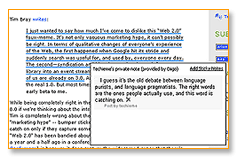IBM didn’t see it coming, but Microsoft does. They are smart. That’s why we’re aligned with them. 😉
What is this perfect storm? What happened to IBM? IBM got hit by the PC revolution, economies of scale. The tremendous book “The long tail” makes two superb points:
- The internet allows the long tail to operate, where brick and mortar stores truncate this natural phenomena – by restoring the long tail to your business you can add up to 35% to your revenue
- The world economy always reorganizes itself around free (or near free) resources. When we built ships, the seas were “free” to sail on and so we sailed and traded. And so on, as growth reveals more “free”, the world adjusts economically around that free resource. China, India, Indonesia and Russia suddenly revealed near free (relative to US and European salaried rates) employees and the world reorganized around that.
Item one above is interesting… item two is compelling. And now we have Google. Their stuff is free. And Microsoft’s stuff is not. Now hold on… before you sigh and give up and close the browser, just stick with me and see where this is going. I suggesting that like the discovery of ships led to a vast new past time (sailing and trading) this free resource will lead to things only 1 year away that we never imagined.
What is Google offering… when you swallow these facts, you might be able to see why Microsoft is plunking down $2billion per year to create their own data-centers!
I don’t open MS Office any more
Google GMail was good. Google Apps for your domain is awesome. (Google Apps). I now send and receive through gmail but using my EXISTING company email addresses. NOT my gmail address. Since I moved to the Google Apps version of GMail, I only opened Outlook to export my contacts. Really. Bye bye Outlook. Google Writely is a free Ms Word, Google Spreadsheets… except that it’s free. Google Calendar.
I doubt I will renew my MS Office subs… I don’t need it any more! I simply do not use it. Except for the development environment, like Atlas and so on. But as my next point explains, that might not be for too long.
UPDATE: Today I opened Frontpage to edit some HTML.
No more SQL Server licenses?
Google got my corporate mail and of everyone working on reBlogger. What else will they take?
You might not get that heading right away. Look at this. You know about Google Base where I can define my data structure and then generate pages to expose the data. The data is hosted by Google’s servers.
Now entering into this picture is Google Base and the Google Database API where you can write against this “GData” and access it from your own servers. Unlimited free data hosting on a server where you don’t have to worry about scalability? No more budgeting for 20 million of backend server racks. This is profound. Sayonara to SEO… look at the BASE slogan: “post it on base. find it on google”.
UPDATE: I found an article about gbase being moved into the retail sector. Lookout amazon!
I know what you’re thinking… the latency between your server and the Google servers would make it unworkable. But what if they hosted the application, just as they now host my company email? Enter Google Page Creator.
It’s all free
I confidently said to my co-worker about 2 months ago that within 1 year I wouldn’t be using MS Office any more. He doubted me. It’s 2 months later. I don’t use MS Office any more.
I am hesitant to say when we will stop using the .NET web developer stuff… there is far more for Google to have to build before I can use it. But the offer of not having to build an enormous backend for my online reBlogger business is just so tantalizing. Not having to write code for storing and indexing the masses of data that reBlogger collects and stores… ohhh yeaahhh.
Every blogging company (eg wordpress etc.) would just leap at free hosting of their data. You bet! And automatic inclusion into the Google results!? Of course! Woohoo!
But look a bit further down the road. Take technorati as an example. If they built for the Google “Platform” (developers! developers! developers!) then they wouldn’t need to collect their own data, they simply use GData to mine the EXISTING Google data store. Now can you imagine what we could do if Google hooked GData into their existing data store?
This idea is already being explored by the Alexa crew with their APIs, but they don’t appear to have the vision and based on my interaction with them during the year, they don’t value interaction with mere mortals and don’t want to meet the needs of these mere mortals. Hey, that’s ok, Google or Microsoft will.
Why Microsoft won’t be an IBM
Because Gates is smart enough to see this coming. Oh, wait. Gates is leaving. But they will see it, I have no doubt about it. Their decision to spend $2billion on server farms tells me that they are responding. But their cash cows are under threat. Someone is cow-tipping over night and we KNOW who is doing it. hehehe.
Industry organizes around near free resources
Google are inventing the “ship” (in the analogy) and the industry will begin to re-organize around the free resource that has been exposed to us: unlimited bandwidth, unlimited hosting, unlimited scalability.
The thing is that they are making money, theirs is not a bubble economy. The revenue model is usage based. It’s going to be interesting!


















 Sick of collecting hundreds of web feeds to cover all the Oracle blogs? Now get all your Oracle news and blog posts in one place:
Sick of collecting hundreds of web feeds to cover all the Oracle blogs? Now get all your Oracle news and blog posts in one place: 







